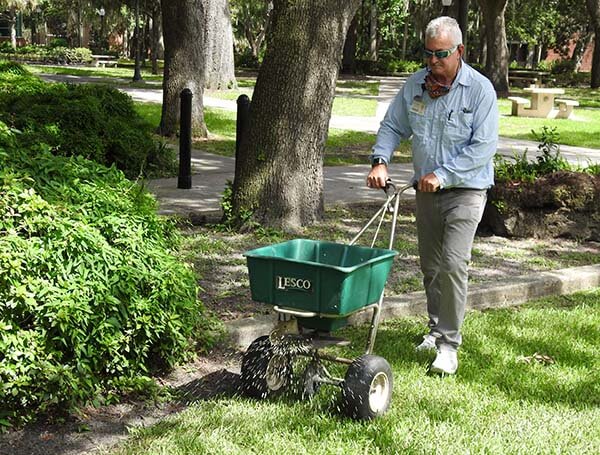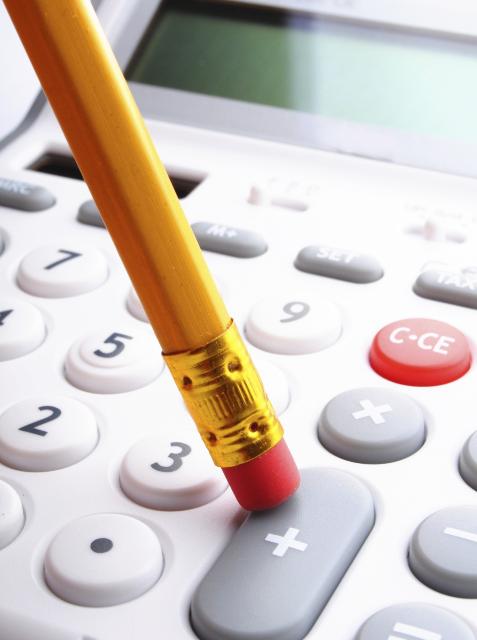
There are a lot of things gardeners need to know to cultivate a beautiful landscape. Between plant zones, scientific names, soil chemistry, and pest identification, being a gardener takes curiosity and willingness to learn new things. Unfortunately, one topic that needs to be well understood, especially when it comes to applying pesticides and fertilizers, is a subject that many cringe when they hear it – mathematics!
Some of the most common mathematical concepts to have a good grasp on for gardening include area, converting decimals to percentages and vice versa, estimating volume and converting units, and determining how much fertilizer to be applied based on your fertilizer grade.
Here’s a couple tips to help you gardeners out with math.
Area
Most often, we need to know the square footage of our gardens. Rectangles are straightforward, you multiply length (in feet) by width (in feet) to get feet squared. Since most yards are not rectangles, we sometimes need to use other shapes to best calculate the area, such as circles and/or triangles. The area (A) of a circle is , where “π” is 3.14 and “r” is the radius (half of the diameter or the distance from the center to the edge). Remember that the little raised 2 means you multiply the radius by itself twice, not by two.
Most of the time, square feet is the best area unit to use. But just in case you need to know, one acre equals 43,560 square feet. So, if you find your lawn is 10,000 square feet, that means you have 0.23 of an acre (10,000/43,560).
Percent Conversions
This one may be better understood by most, but this becomes important later when we determine fertilizer needed or doing volume conversions. Basically, any percent can be divided by 100 to convert it to a decimal that can be used easily in other calculations. For example, 15% is the same as 0.15 (15/100). The easy way to remember is that 100% is the same as one, and 50% is the same as 0.5.
Volume Estimation and Conversions
Determining volume is required when figuring out how much mulch is needed for a garden bed or soil required for a raised bed. Converting one unit to another is especially important when determining how much pesticide product is needed to prepare a mixture.
For mulch and soil, the cubic feet (cf) or cubic yards (cy) are needed to figure out how many bags or truckloads will be needed. Most bulk products are sold by the cubic yard. Since we are dealing with volume, we need three measurements, the length, width, and depth. If we want to add three inches of mulch to a 500 square foot garden, we multiply the 500 by 0.25 feet (3”/12” equals 0.25 inches) to get 125 cubic feet. That is about 62 bags of mulch from the hardware store, which are often sold in 2 cubic foot bags. If we divide 125 cubic feet by 27 (three feet in a yard so 3’ x 3’ x 3’ = 27) we now have the answer in cubic yards and find that we need about 4.5 cubic yards of mulch. One cubic yard is roughly a half of a full-size pickup truck bed.
When it comes to converting liquid volume units to help with pesticide mixtures, fortunately we have the internet to help. However, it is a good idea to at least be familiar with converting ounces to gallons and vice versa. Since 128 ounces equals 1 gallon, to go from gallons to ounces you multiply by 128. For example, 0.5 gallons equals 64 ounces (0.5 x 128). To go from ounces to gallons, we just divide by 128. For example, 192 ounces equals 1.5 gallons (192/128).

Calculating Fertilizer Needed
Okay, bear with me, as we are about to do some hard math and piece together several of the above concepts. First of all, most fertilizer rates are provided by extension resources and given in terms of pounds of a particular nutrient for a set area, usually 1,000 square feet. For example, when using slow-release fertilizer a homeowner should apply no more than one pound of nitrogen for every 1,000 square feet of lawn. To figure out how much actual fertilizer to apply to meet the recommendation, we will need 1) the recommended rate, 2) the size of the lawn, and 3) the fertilizer grade on the product (the three numbers that represent the percent N, P, and K). Our rate is one pound nitrogen per 1,000 square feet. The size of our lawn is 50 feet by 30 feet, so 1,500 square feet. We are going to use a 16-0-8 fertilizer. Now, here is the hard part! To figure out how much of our 16% nitrogen fertilizer will provide one pound of nitrogen, we need to convert 16% to a decimal (16/100 = 0.16) and then divide the amount of fertilizer we need by that number – 1 pound/0.16 – to find that 6.25 pounds of our fertilizer product are required for each 1,000 square feet. Since we have 1,500 square feet, we need to multiply our answer by 1.5, which gives us a total of 9.4 pounds.
Math is hard and there are usually many methods to get the same solution. When using pesticides and fertilizers in the home landscape, it’s important to make sure we’re using the right amount of materials to minimize the chance of harming ourself, our plants, and the local environment. If you need help, or would like someone to check your work, contact your local extension office.
- Let Extension Diagnose Your Landscape Issues - May 28, 2025
- No Mow March 2025! - February 27, 2025
- New Year’s Resolution Ideas for Gardeners - January 16, 2025

